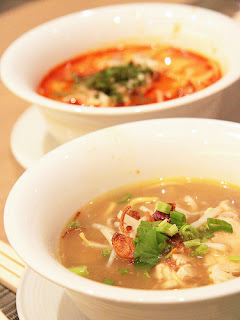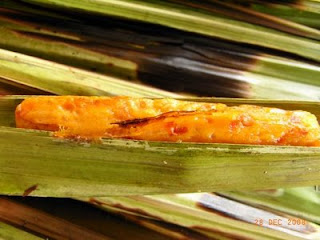FROZEN YOGHURT <3
Thursday, 28 July 2011
Tuesday, 12 July 2011
Kuih Dadar
Kuih dadar or kuih tayap is a rolled crepe flavored with pandan juice and filled with grated coconut steeped in gula melaka or Malaysian palm sugar. Pandan leaf is the core ingredient of kuih dadar/kuih tayap. The green exterior of kuih dadar is made of batter colored with natural pandan juice extracted from pandan leaves.
Sambal Goreng
Onde-onde
The cute little onde-onde–also spelled as ondeh-ondeh–are infused with pandan (screwpine leaf) juice and filled with “Gula Melaka” or palm sugar and then rolled in with some fresh grated coconut. The palm sugar that’s in it literally bursts in your mouth when you take a bite. They are sweet and delicious!
Asam Pedas
Asam Pedas, or literally “sour spicy,” is a classic Malaysian dish. Ask any home cooks in Malaysia–Malay, Chinese, or Indian–and you are bound to get various recipes for Asam Pedas. Everyone has their own interpretation for this favorite dish and there are endless adaptations; suffice it to say, it’s sour, fiery hot, and tastes extraordinarily satisfying… The main ingredients (usually seafoods or freshwater fishes) were cooked in asam (tamarind) fruit juice with chilli and many other spices.
Mee Soto
Mee Soto - the base for this dish is a stock made from chicken and a special Rempah, which varies from stall to stall. Blanched Hokkien Mee and pieces of shredded chicken are then drowned in this aromatic and tasty soup, and topped with chopped spring onions and crispy fried onions. The dish is also served with Begedil and should be eaten with the hot but extremely delicious chilli condiment.
Lontong
Lontong is an Asian dish made of compressed rice wrapped inside banana leaf that is then cut into small cakes as staple food replacement of steamed rice. The smaller size of lontong filled with vegetables (carrot, common bean and potato) sometimes also filled with meat, are eaten as snack.
Popular in Indonesia and Malaysia, the dish is usually served cold or at room temperature with sauce-based dishes such as gado-gado and salads. It is also used in Soto as an alternative to vermicelli noodles.
Cendol
Cendol is a common and popular cold dessert sell in hawker stall or food courts. It is served in a cold mixture of coconut milk, brown syrup made from local gula melaka and shaved ice. Apart from this serving combination, Cendol is also often served with glutinous rice, red beans and rich coconut milk. It is a perfect beverage, especially during hot days.
Mee Rebus
It is yellow noodles served with a thick spicy potato-based gravy and garnished with a hard-boiled egg, spring onions, bean sprouts, fried shallots, tau kwa (dried/ fried beancurd) and lime juice. The gravy is really thick, rich and flavourful with a hint of sourness from the tamarind paste and also the lime juice.
Dodol
Dodol is a toffee-like sweet food delicacy popular in Indonesia, Malaysia and Singapore. It is made with coconut milk, jaggery, and rice flour, and is sticky, thick and sweet. It normally takes up to 8–9 hours to be cooked. Dodol is commonly served during festivals such as Eid ul-Fitr and Eid al-Adha. There are many flavours of dodol available including durian, coconut and jackfruit flavors.
Epok-Epok (Curry Puffs)
Curry puffs are commonly seen in Singapore's Pasar Malams and other stalls in shopping centres. Additionally, the epok-epok is a popular variation in some of Singapore's hawker centres, usually amongst Malay stalls. Alternatively, the more common type of curry puff has a thick or flaky English-style crust, with a mixture of Chinese and Indian styles in the filling. The fillings can vary from veggies, potatoes, sardines, curry etc.
Otak-Otak
Fresh fish fillets are blended with light spices, coconut milk, lime leaves and other aromatic herbs, into a sort of fish mousse. The fish mousse is wrapped in banana leaves and steamed or grilled. It makes an exotic appetizer or cocktail party bite!
Beef Rendang
This hot, dry spiced dish of tenderly simmered meat offers the typical Malaysian taste of coconut, balanced with robust, tangy spices. Rendang is a must-have on special occasions such as weddings, ideally served with nasi kunyit [turmeric rice].
During Ramadan & Eid, the Malay New Year, Rendang is sure to take center stage on bountiful tables of feast in homes everywhere. During this festive season, a special rice cake called Lemang is made to eat with Rendang.
Laksa
Thick rice noodles are served in a tangy fish soup/gravy. Not at all fishy, the soupy gravy is made with mackerel and lots of aromatic herbs. Fresh garnishing of shredded cucumber, lettuce, pineapple, onion and fragrant mint leaves finishes the dish. In general the term Laksa refers to Malay style laksa, sometimes called Malay Laksa. There are slight variations in different parts of the country. The key ingredient is tamarind, used as a souring agent, giving it a tart tangy taste. This version of laksa from the 'hawker food capital' - Penang, is especially famous and well known as Penang Laksa or Penang Assam Laksa.
Hjh Maimunah
Hjh Maimunah Restaurant & Catering Pte Ltd. is a name familiar in relation to traditional, kampung-styled cuisine. Located at Jalan Pisang and Joo Chiat Rd, they are known for their fine selection of signature dishes. There are wide selections of food for you to choose from and some of their popular dishes are sambal goreng, beef rendang and lemak siput among many others.
Roti Jala
Roti jala is a net-like of crepe made from flour batter, usually served along with curry. A special cup or mould with small holes is being used to shape the roti jala cooked on a hot griddle. Although it is time consuming to make, but it is quite easy to whip.
Sambal
If Korea has Kimchi, Japan has Wasabi, The Malays have Sambal! Sambal is a chilli-based sauce mainly used as condiments in dishes. It is typically made from variety of chilli peppers and can be extremely spicy according to the chillis added. There are many types of sambal such as sambal kacang, sambal asam, sambal udang and being the most famous one, sambal belacan.
Simpang Bedok
Simpang Bedok is a popular eatery located at Bedok. Many people come here just to hang out, have some food and catch up with friends. Thus it is common to see diners staying for a couple of hours. There is a wide variety of foods and the price is quite cheap. In addition there are flat-screen televisions to provide some entertainment. The area is extremely popular on weekends and evenings and it can be relatively difficult to get a seat or your food served fast during this time.
John's Bread
Roti John, a food which can be easily found at any pasar malam, is a popular Malay snack item. The word 'Roti' means bread in English. While the origin of the 'John' in the name is allegedly due to the Western origin of Baguette.
The main ingredients for Roti John are minced meat, egg and bread. And don't forget to spread over some chilli sauce and mayonnaise before eating!
Satay (BBQ Sticks)
These little skewers of meat with peanut sauce and ketupat (Malay rice cake) is a very popular and favorite dish in Malaysia and Singapore. The marinated meat; chicken or beef, are skewered onto bamboo sticks and grilled over hot charcoals. A fresh salad of cucumbers & onions are served together with a spicy-sweet peanut sauce for dipping.
Nasi Lemak (Coconut-flavoured Rice)
Nasi Lemak is rice cooked with coconut milk and mixed with pandan leaves to make it aromatic. It is typically being served with sambal, ikan bilis (dried anchovies), egg, sliced cucumbers & roasted peanuts. The Malays enjoy eating it during breakfast, traditionally wrapped in banana leaf most of the time.
Subscribe to:
Comments (Atom)





















